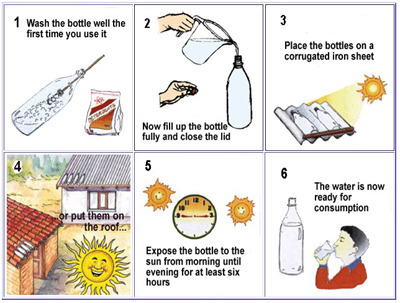Small Scale Water Purification
 Heaven forbid that anyone here should be caught in a disaster without clean potable water, but it could happen. What I wish to describe is a cheap, easy way to create a do-it-yourself portable water filtration and purification system for emergencies. Even if you are a survivalist preparing for the collapse of civilization, Armageddon, the Zombie Apocalypse, or the tyrannical government coming for your guns, and have bought an expensive water treatment system plus cartridges and tablets, eventually your fancy system will wear out, your cartridges will clog, and you'll use up all your tablets. The system I will describe is almost foolproof and will work indefinitely.
Heaven forbid that anyone here should be caught in a disaster without clean potable water, but it could happen. What I wish to describe is a cheap, easy way to create a do-it-yourself portable water filtration and purification system for emergencies. Even if you are a survivalist preparing for the collapse of civilization, Armageddon, the Zombie Apocalypse, or the tyrannical government coming for your guns, and have bought an expensive water treatment system plus cartridges and tablets, eventually your fancy system will wear out, your cartridges will clog, and you'll use up all your tablets. The system I will describe is almost foolproof and will work indefinitely.First, collect 2-liter pop bottles and remove the labels. A few can be colored, but most should be transparent. Cut the bottoms off the colored ones and attach lines to them so they can be hung upsidedown; these will be the filtering bottles. Leave the transparent ones intact and don't lose the bottle caps; these will be the storage bottles.
Next, take a wad of cotton or cheesecloth and plug the inside of the narrow neck of the filtering bottles. The neck is where the filtered water will drip out and the plug is to keep the filtering material from falling out.
Fill the bottom of the filtering bottles with activated charcoal to a depth of two inches. Activated charcoal is charcoal processed to be porous. If you can't buy it, you can make a crude form by burning sawdust or wood chips to ash. Even the charcoal from a campfire will work as long as it is pulverized to powder.
The next layers depend upon what material you have available. The most basic is a few inches of sand topped by a few inches of gravel, but you can use fine sand and course sand, diatomaceous earth and sand, or diatomaceous earth, sand, and gravel. Be sure to leave a few inches of open space at the top as a reservoir for water.
The principle is that as the water flows by gravity from the reservoir down through the layers and out the neck at the bottom, the layers remove smaller and smaller particles until the water is clear. The charcoal will then remove toxins, metals, and chemicals. Also, organisms will colonize the gravel and sand, creating a biofilm that will consume dissolved organic material and kill harmful and infectious organisms. The system works best if the water is fairly clear to begin with, so if the water source is cloudy or murky, you should allow the water to stand for a couple hours in a bucket to allow as much material as possible to settle out. In fact, the cleaner the source is, the better the system will work and the longer it will last.
Also, the system should be run continuously as much as possible, not only to insure a continuous supply of water, but also to keep the bottle from drying out. If it can't be run continuously, the neck should be capped and the reservoir filled to keep the system wet until it is needed again. The beauty of this system is that if it becomes clogged or the water quality worsens, the contents can be dumped and the bottle refilled.
The water that comes out, however, is not yet fit to drink. It will still contain bacteria, protozoans, and parasites, so it needs to be sterilized first. This can be accomplished by bringing the water to a rolling boil for 10 minutes, but there is an easier way, and that's where the clear bottles come in. Each is filled leaving a few inches of air at the top and sealed with a cap. They are then shook up and laid out in the sun. The ultraviolet light from the sun will destroy microorganisms by damaging their DNA, and organic pollutants by creating oxygen free radicals that break them down into carbon dioxide. That's why plastic needs to be used (glass blocks ultraviolet rays) and the bottle must be clear and free of labels. This process works best if the bottles are placed on corrugated tin. If the sky has less than 50% cloud cover, a single day's exposure from dawn to dusk is sufficient to render the water drinkable, but more than 50% will require up to 2 days. Only continuous rainfall makes the process unworkable.

Once the water has been sterilized, it will remain so as long as the bottle is not opened and the water removed. As such, when the bottle is opened the water needs to used as soon as possible to prevent recontamination.
With half a dozen filtration bottle running more or less continuously and plenty of storage bottles on hand, clean drinkable water can be made available as needed. This system can also be scaled up if larger containers are available.
Published on December 14, 2013 15:43
•
Tags:
green-technology, sanitation, survival, water
No comments have been added yet.
Songs of the Seanchaí
Musings on my stories, the background of my stories, writing, and the world in general.
- Kevin L. O'Brien's profile
- 23 followers



